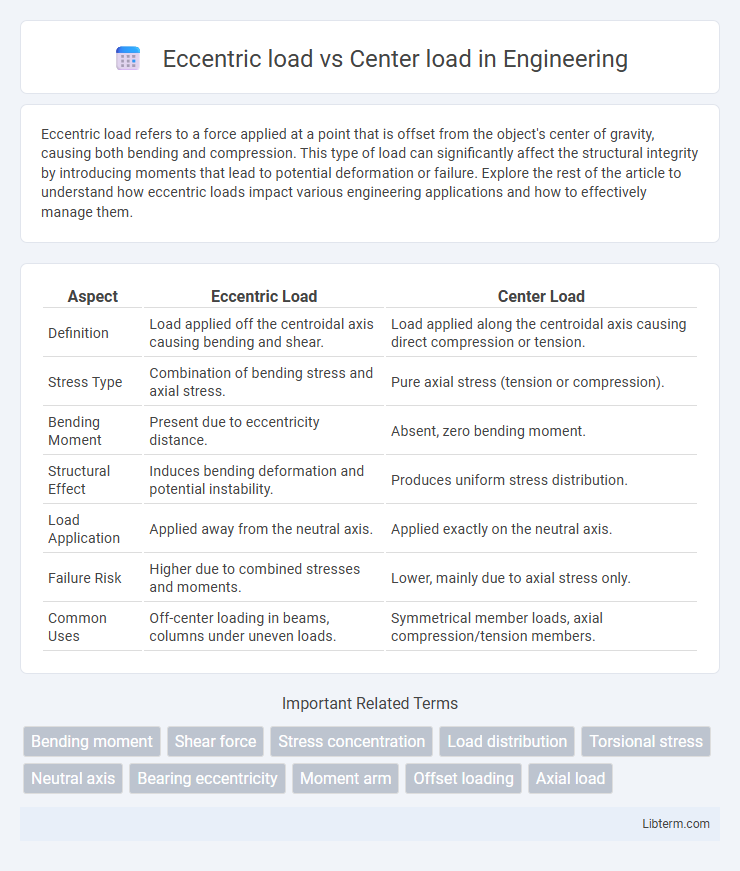Eccentric load refers to a force applied at a point that is offset from the object's center of gravity, causing both bending and compression. This type of load can significantly affect the structural integrity by introducing moments that lead to potential deformation or failure. Explore the rest of the article to understand how eccentric loads impact various engineering applications and how to effectively manage them.
Table of Comparison
| Aspect | Eccentric Load | Center Load |
|---|---|---|
| Definition | Load applied off the centroidal axis causing bending and shear. | Load applied along the centroidal axis causing direct compression or tension. |
| Stress Type | Combination of bending stress and axial stress. | Pure axial stress (tension or compression). |
| Bending Moment | Present due to eccentricity distance. | Absent, zero bending moment. |
| Structural Effect | Induces bending deformation and potential instability. | Produces uniform stress distribution. |
| Load Application | Applied away from the neutral axis. | Applied exactly on the neutral axis. |
| Failure Risk | Higher due to combined stresses and moments. | Lower, mainly due to axial stress only. |
| Common Uses | Off-center loading in beams, columns under uneven loads. | Symmetrical member loads, axial compression/tension members. |
Introduction to Eccentric and Center Loads
Eccentric loads occur when force is applied off-center from an object's neutral axis, creating bending moments that induce stresses beyond simple compression or tension. Center loads act along the neutral axis, producing uniform stress distribution without bending effects in structures or mechanical components. Understanding the difference between eccentric and center loads is crucial for accurate structural analysis and design, ensuring safety and performance.
Defining Eccentric Load
Eccentric load refers to a force applied at a point that does not align with the object's centroid, causing bending and torsional stresses alongside direct compression or tension. Unlike center load, which acts through the centroid and produces uniform stress distribution, eccentric load results in uneven stress, increasing the potential for structural instability. Understanding eccentric load is crucial in engineering design to prevent material failure and ensure safety under asymmetric loading conditions.
Understanding Center Load
Center load refers to the application of force directly along the object's central axis, ensuring uniform distribution across the structure's cross-section. This type of loading minimizes bending moments and shear stresses, enhancing structural stability and reducing the risk of deformation or failure. Understanding center load is crucial for designing components that maintain equilibrium and support maximum load capacity efficiently.
Key Differences Between Eccentric and Center Loads
Eccentric loads exert force away from the object's central axis, causing bending and torsional stresses, while center loads act directly through the centroid, resulting primarily in axial stress. The key difference lies in load application point--eccentric loads induce combined stress states leading to potential structural instability, whereas center loads maintain uniform stress distribution, enhancing stability and predictability. Understanding these differences is crucial for accurate structural analysis and ensuring safety in design applications.
Structural Implications of Eccentric Loads
Eccentric loads generate bending moments and shear forces in structural elements, causing stress concentrations that differ significantly from the uniform stress distribution seen with center loads. These bending stresses can lead to deformations such as tilting, rotation, and potential instability, requiring careful design consideration to ensure structural safety and serviceability. Engineers must account for these effects by reinforcing sections, optimizing cross-sectional shapes, and performing detailed stress analysis to prevent failure under eccentric loading conditions.
Structural Implications of Center Loads
Center loads apply force uniformly along the structural axis, resulting in predictable compressive stresses and minimal bending moments, which enhances overall stability and reduces the risk of structural deformation. This load distribution is ideal for columns and beams as it optimizes material strength and prevents eccentric forces that cause bending and shear stresses. Properly managed center loads improve load-bearing capacity and ensure the structural integrity of frameworks under vertical loads.
Practical Applications in Engineering
Eccentric load occurs when a force is applied off-center, generating bending moments and shear forces that affect structural behavior and stability, critical in beam design and column analysis. Center load applies force along the centroid of a member, resulting in pure axial stress, commonly used in columns and compression members to maximize load-bearing capacity without inducing bending. Understanding the distinction guides engineers in designing safer bridges, buildings, and mechanical components by predicting stress distributions and preventing structural failure.
Advantages and Disadvantages of Each Load Type
Eccentric load causes bending and shear stresses in structures, leading to uneven stress distribution and potential deformation, but it enables design flexibility for offset loads and can simulate real-world conditions more accurately. Center load applies force along the centroid, resulting in uniform axial stress and simpler analysis, which enhances structural stability and reduces the risk of bending failure, though it limits application to perfectly aligned forces. Choosing between eccentric and center loads depends on specific structural requirements, load conditions, and desired performance outcomes.
Common Mistakes and Considerations in Load Placement
Eccentric load placement often causes uneven stress distribution, leading to structural instability or failure, a common mistake in load management. Center load placement ensures uniform load distribution, reducing bending moments and shear forces, which is critical for maintaining structural integrity. Incorrect assumptions about load positioning can result in inefficient material use or unexpected deformations, emphasizing the need for precise load placement analysis in engineering design.
Summary and Best Practices for Load Management
Eccentric load applies force away from the center of an object's mass, causing bending or twisting, while center load directs force through the object's centroid, ensuring balanced stress distribution. Best practices for load management emphasize positioning loads as close to the center as possible to minimize structural stress and increase stability. Regularly assessing load alignment and utilizing appropriate support systems can prevent deformation and extend the lifespan of the structure or equipment.
Eccentric load Infographic

 libterm.com
libterm.com